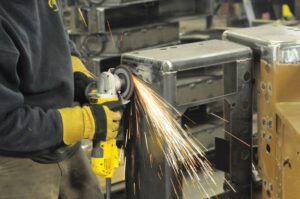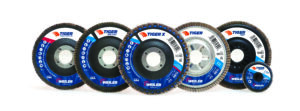Flap Discs: The Right Selection and Technique Can Save Time and Money
Even though flap discs are disposable, there are steps that can be taken to lengthen their usability. The result is less downtime, more work and greater savings.
Posted: January 24, 2024
In any metal grinding or finishing application, it is important to have the correct product for the job — it minimizes the risk of removing too much material and reduces the time and cost for the process. When working with thinner materials, flap discs are often a good choice. Flap discs offer reliable grinding action, while also allowing for more delicate blending and finishing work.
Flap discs are constructed with the same grain types as found in bonded abrasives, but their layered construction gives them a much softer, more forgiving feel. As a result, they are ideal for grinding and finishing a product — at the same time — which helps save time and money. They do not, however, work as well for finishing rougher surfaces that require more aggressive action, such as a material with torch slag. A grinding disc is better suited here, as the flap disc’s cloth can catch and/or tear too easily.

These discs feature coated abrasives that adhere grains to a backing cloth, typically a cotton, polyester or blended material. This abrasive cloth is then cut into smaller flaps and layered radially to form the flap disc.
How a flap disc performs is largely related to the abrasive material used and the grit size. There are three primary cutting grains used: aluminum oxide, zirconia alumina and ceramic alumina.
The flaps wear away as the grains deplete, which exposes fresh and sharp grains below. When used properly, a flap disc can essentially be used until the cloth is almost completely worn down to the back plate.
In general, flap discs are designed for use on right-angle grinders at angles from 5° to 35°. A Type 27 flap disc is best for finishing and applications that require lower grinding angles ranging from 5° to 15°. A Type 29 flap disc is best for more aggressive, higher-angle grinding, between 15° and 35°.
Choosing the best flap disc for the job and maximizing its effectiveness and longevity can be confusing. Before making your final selection, consider these three main factors: 1) the surface finish requirements and desired aesthetics, 2) the time, productivity and efficiency requirements and 3) the labor and consumable costs involved.
Selecting the Best Grain and Disc Size
It is important to choose a grain that is appropriate for the metal being cut and a grit appropriate for the application. Considering the objectives and priorities for the finished weld is key to making the right choice. Generally speaking, to ensure the best possible finish, choose the highest grit possible that gets the job done.
In addition to standard-density flap discs, there are also high-density — or jumbo — flap discs. These flap discs have more cloth on them, which makes them thicker, softer and longer lasting. High-density flap discs are the best choice for grinding on curved or irregular surfaces.
Flap discs are made in different sizes, too, ranging from 2” to 7”. A 2” disc can essentially replace a blending disc and gives an operator up to 15 times the use. Reducing the number of product changeovers can have an immediate and dramatic effect and significantly lower the overall cost of use.
Choosing the Abrasive Material
Aluminum oxide is a common choice when a consistent, low-cost product is needed, but the most common flap disc used today is zirconia alumina. A blend of zirconia alumina and aluminum oxide grains, this type of flap disc provides the most versatility for the lowest cost benefit. Although it is slightly more expensive upfront than an aluminum oxide flap disc, it is more heat resistant, tough and durable, and maintains its sharpness for a longer period of time.
The third choice of abrasive material is ceramic alumina. The grains on these flap discs micro-fracture to enable a continuous supply of the sharpest edges, and they are more resistant to heat. Ceramic alumina flap discs are the most expensive option, but they last the longest out of the three types. Keep an open mind when selecting the best abrasive for your application.
When considering a ceramic flap disc, the operator must decide whether the increased longevity is worth the extra money, factoring in details such as the reduction in downtime for changeover and the reduction in inventory for extra products. Many times, the more expensive ceramic flap disc provides the lowest overall cost of use when these factors are considered.
In the end, the goal is to find the flap disc that accomplishes the application’s requirements within a desired timeframe and budget.
Using the Correct Technique
To maximize effectiveness and longevity of a flap disc, it’s important to use the proper pressure at the proper angle.
Putting too much pressure on a flap disc when it does not work fast enough can cause premature wear or lead to gouging, undercutting or heat buildup and discoloration. If you find yourself needing to push harder to get a disc to perform, consider a coarser grain. Using too much pressure can also undercut, gouge or damage the workpiece. Premium cutting grains like ceramic alumina require maximum tool speed. Excessive pressure can cause the grinder to “bog down,” actually reducing the grain’s cut rate. Glazing or dulling of the grain can also occur, limiting the disc’s ability to cut. Once this happens, the disc must be discarded — even if it’s only partially used.

Similarly, grinding at too steep of an angle causes the operator to work much harder because they’re not using the full width of the cloth. Grinding steep also puts increased pressure and stress on the flap overhang, which can reduce product life.
When finishing thin weld material, in particular, it’s important not to remove too much of the metal, which creates a weak point. This is another good reason to select the least aggressive disc that will do the job, especially when tighter tolerances are required. Undercutting or gouging the thin material could ultimately ruin the workpiece. In applications where these issues are real concerns, it is usually best to use a higher grit — such as 60 or 80 — rather than a 36- or 40-grit disc.
When using flap discs, don’t try to judge whether a disc has been fully used based on flap wear. Flap discs are designed to be used to the point where you can see glue through the flap. When used properly, a flap disc will continue to cut until this glue is visible. This single insight, when shared with all operators, can save significant product costs annually.
Remember, even though flap discs are disposable, there are steps that can be taken to lengthen their usability. The result is less downtime, more work and greater savings.
{SIDEBAR}
How to Trim a Flap Disc
Some flap discs feature a trimmable backing plate that can be removed progressively to establish the desired flap overhang. This feature provides the operator with a more versatile product for multiple jobs and can extend the product life.
Every flap disc manufacturer has recommendations for trimming. A common one is a maximum trim of 3/8” from the edge of the original backing plate. It’s also important to remember that not all plastic-backed flap discs are trimmable. Trimmable flap discs use composite or glass-filled nylon back plates — not plastic — that allow the edge to be trimmed without shattering. Before trimming any flap disc, make sure the disc is marked or rated as trimmable, and always read and understand the manufacturer’s recommendations.
To achieve the best results, follow these steps:
- Select a sharp piece of scrap metal.
- Ramp the flap disc up to speed.
- Slowly lift the flap disc until the flap’s top (or overhang) contacts the scrap metal.
- Push directly into the corner of the metal with consistent, controlled pressure.
The process may take some practice to perfect, but in the long run it can save time and money.


















